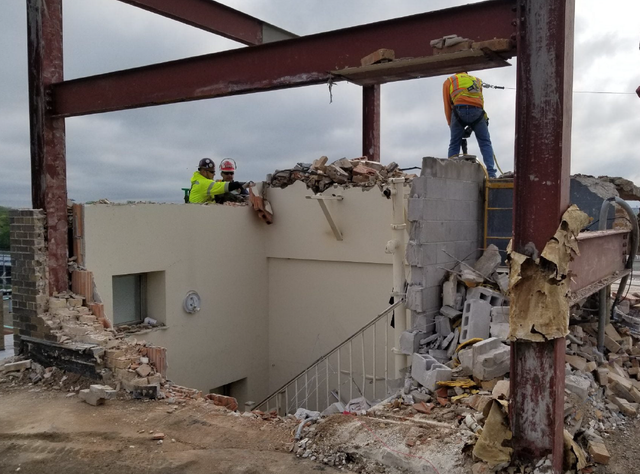Transforming Areas: Interior Demolition for Residential and Commercial Projects
Transforming Areas: Interior Demolition for Residential and Commercial Projects
Blog Article
The Ultimate Overview to Inside Demolition Techniques and Tools
Within the realm of interior remodellings, the art of demolition is a pivotal phase that requires precision, skill, and the right collection of tools. Whether you are an experienced professional or a Do it yourself enthusiast, recognizing the ins and outs of interior demolition methods can make all the difference in achieving a successful task end result.
Necessary Indoor Demolition Tools
When taking on interior demolition tasks, having the ideal tools is crucial for efficiency and safety and security. One of the most vital tools for interior demolition is the demolition hammer. This sturdy tool is developed to break through hard materials like drywall, concrete, and tile.
One more essential tool is a reciprocating saw, which is best for cutting through a range of products such as plastic, metal, and timber. Its capability to make specific cuts in tight spaces makes it optimal for demolition job. In addition, an utility knife is required for reducing materials like rug, vinyl flooring, and insulation. Its sharp blade makes certain accurate and tidy cuts, helping with the removal of undesirable materials. On the whole, having these vital interior demolition tools will considerably boost the effectiveness and safety of any kind of demolition task.

Safety And Security Precautions During Demolition

Additionally, all employees entailed in the demolition process ought to obtain adequate training on the appropriate handling of tools and tools to minimize accidents. By adhering to these security preventative measures, indoor demolition projects can be lugged out efficiently while prioritizing the wellness of all individuals included.
Methods for Removing Walls
Executing correct safety precautions during interior demolition tasks is important for creating a safe and secure working atmosphere, and one vital aspect of such jobs includes understanding methods for getting rid of wall surfaces. One typically utilized approach is hands-on demolition, which needs the usage of standard hand tools such as sledgehammers, crowbars, and utility knives to thoroughly dismantle the wall surface item by item. This method permits for higher control over the demolition process, specifically in delicate locations where precision is important.
For larger, much more complex wall surfaces, mechanical demolition may be necessary. This involves using hefty equipment like excavators or bulldozers to knock down wall surfaces efficiently. It is essential to make certain that the architectural honesty of the structure is not jeopardized throughout mechanical demolition.
An additional strategy for removing walls is deconstruction, where the wall surface is dismantled in a manner that protects reusable materials. This lasting strategy is ecologically friendly and can additionally assist reduce disposal prices. Whichever strategy is utilized, it is essential to comply with correct security protocols and think about the structural effects of wall elimination to ensure an effective interior demolition job.
Removing Floor Covering Like a Pro
Successfully eliminating floor covering during interior demolition calls for the appropriate tools and methods to make certain a smooth and successful procedure. The initial step in removing floor covering is to clear the location of any kind of furniture or obstacles. Next, identify the kind of floor covering to figure out the appropriate elimination method. For hardwood or laminate flooring, beginning by removing the baseboards and check this then utilize a floor covering scraper to raise and remove the planks. Carpeting removal entails cutting the carpeting into manageable areas and rolling it up for disposal. For ceramic tile or vinyl floor covering, a sculpt or floor scraper can be used to tear up the floor tiles or sheets. It's necessary to put on safety gear such as gloves, safety glasses, and a mask to avoid injuries and direct exposure to dirt and particles. Additionally, having a dumpster or marked disposal location ready for the eliminated floor covering materials is crucial for keeping a clean workplace. By complying with these techniques and using the right devices, getting rid of floor covering like a pro can be accomplished efficiently and properly.
Proper Waste Disposal Methods
After effectively removing flooring using the appropriate tools and methods, the next vital step in the interior demolition procedure is applying correct waste disposal techniques. Appropriate waste disposal is necessary for preserving a secure and clean job atmosphere during and after demolition.

Professionals should comply with local guidelines regarding waste disposal to avoid fines and charges. Using expert waste administration solutions can simplify the disposal have a peek at this site procedure and make certain conformity with environmental standards. By executing appropriate waste disposal techniques, indoor demolition jobs can be finished successfully and sustainably.
Conclusion
In conclusion, indoor demolition requires the usage of necessary tools and strict safety and security preventative measures to guarantee a successful and secure procedure. By complying with these guidelines, indoor demolition can be completed successfully and with very little risks.
One of the most critical devices for indoor demolition is the demolition hammer (interior demolition). On the whole, having these crucial indoor demolition tools will considerably improve the efficiency and safety of any type of demolition project
Efficiently removing floor covering during interior demolition needs the proper tools and methods to make click to read more certain a smooth and successful procedure.After successfully removing flooring utilizing the proper tools and methods, the following critical step in the indoor demolition procedure is implementing correct waste disposal techniques.In verdict, interior demolition needs the usage of essential tools and rigorous safety precautions to ensure a risk-free and effective procedure.
Report this page